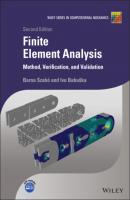Finite Element Analysis. Barna Szabó
Чтение книги онлайн.

Читать онлайн книгу Finite Element Analysis - Barna Szabó страница 27
Название: Finite Element Analysis
Автор: Barna Szabó
Издательство: John Wiley & Sons Limited
Жанр: Физика
isbn: 9781119426462
isbn:
where
which is computed from the given data and the shape functions.
Example 1.5 Let us assume that is a linear function on Ik. In this case
can be written as
Using the Legendre shape functions we have:
Exercise 1.11 Assume that is a linear function on Ik. Using the Legendre shape functions compute
and show that
for
. Hint: Make use of eq. (1.55).
Exercise 1.12 Let
where fk is a constant. Compute numerically in terms of fk and ℓk using 3, 4 and 5 Gauss points. See Appendix E. Use the Legendre basis functions.
Exercise 1.13 Assume that is a linear function on I. Using the Lagrange shape functions for
, compute
.
1.3.5 Assembly
Having computed the coefficient matrices and right hand side vectors for each element, it is necessary to form the coefficient matrix and right hand side vector for the entire mesh. This process, called assembly, executes the summation in equations (1.62), (1.67) and (1.73). The local and global numbering of variables is reconciled in the assembly process. The algorithm is illustrated by the following example.
Example 1.6 Consider the three‐element mesh shown in Fig. 1.5. The polynomial degrees ,
,
are assigned to elements 1, 2, 3 respectively. The basis functions shown in Fig. 1.5 are composed of the mapped Legendre shape functions. For instance, the basis function
is composed of the mapped shape function N2 from element 1 and the mapped shape function N1 from element 2. This basis function is zero over element 3. Basis function
is the mapped shape function N3 from element 3. This basis function is zero over elements 1 and 2.